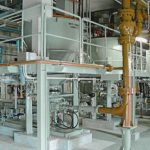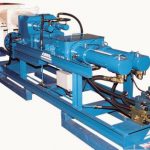As of 2006, municipal and industrial sewage sludges will have to be disposed of by thermal means wherever possible. Handling and transportation of such high-viscosity and high-solids sludges via pipelines will thus become increasingly important, since these permit more flexible routing and avoid the nui- sance caused by odours and fouling. The use of solids handling pumps will facilitate problem-free transportation.
Jörg-Peter Zöllner
With incineration, the sludge is either injected directly into a fluidized-bed incinerator or pumped into a silo for temporary storage. It goes without saying that high-viscosity and high-solids sludges can cause major disturbances when they are conveyed and whenever the system is started up or shut down. If they are not prevented by automatic early detection and immediate control reactions, these disturbances can result in the failure of the complete system. The inevitable, unpleasant outcome is that individual elements of the system have to be opened up and the sludge blockages removed manually, frequently necessitating mining methods.
Process line
The pump conveying system based on the Abel SH solids handling pump consists of a pre-feeder hopper above the twin shaft pre-press screw, into which the discharge screw of the dryer discharges the partially dried sludge. The hopper has vertical walls or, preferably, walls sloping at a negative angle, in order to prevent bridging of the sludge in the hopper. It is equipped with a level probe. In addition to an open area into which the sludge drops, the twin shaft pre-press screw also has a closed tubular section, within which the helical screws generate the feed pressure and force the sludge into the solids pump via a connecting piece. The SH solids handling pump takes the form of a hydrostatically-driven, twin-cylinder, single-acting, positive displacement pump with automatically operated valves. It ultimately pumps the sludge into a pipeline. A slip injection unit is located immediately downstream of the pump. A similar unit, adapted to the external contour, is also installed at the inlet to or outlet from the connecting piece. These injection points are coupled to a metering station. The solids pump, the pre-press screw, the hydraulic unit, the metering station and the level probe in the feed hopper are controlled and monitored by means of a PLC. This PLC is itself connected to the control system for the overall drying plant.
Monitoring and control
The solids pump cylinder and the hydrostatic drive motor for the screw are driven by means of flow and pressure-compensated hydraulic pumps. This permits variable-stroke and variable-speed operation, including safe stopping of the solids pump and/or the pre-press screw while simultaneously maintaining the maximum limit pressures, without heating up the hydraulic fluid and without dissipating energy. The mass flow of sludge is controlled either by altering the incineration temperature – whereby the solids pump must be fed using the level probe by altering the speed of the dryer discharge screw – or, in the case of silo feeding, by regulating the speed of the solids pump itself, again aided by the level probe in the feed hopper.
The sludge conveying process is monitored as follows: using the level probe, it firstly has to be ensured that the screw spirals are only slightly covered, and that they continuously force the sludge into the solids handling pump, in order to prevent blockages from occurring in the feed hopper. The fluid pressure in the screw’s hydrostatic drive motor, which is proportional to the torque, is monitored. lf this pressure exceeds a maximum permissible value, a small quantity of slip additive (water or 0.5 % polymer solution) is injected into the connecting piece until the pressure drops again. If the connecting piece becomes completely blocked as a result of a change in the sludge consistency in the dryer, a movement sensor on the screw shaft indicates that it has come to a standstill and initiates corrective action:
- The speed of the solids handling pump which is still running is significantly reduced and the screw is reversed.
- A solenoid valve that controls a water connection above the pump inlet valves on the connecting piece of the solids handling pump is opened to fill the cyl-inder with water.
- The solids handling pump valves are switched to reverse for a short time (one stroke of one of the sludge pistons), so that the inlet valves become outlet valves. The water forces the jammed plug of sludge back towards the screw discharge channel, while the reversed feeder screws simultaneously break up this sludge.
- The system is then switched back to normal conveying. This process takes place so quickly that the level of sludge in the feed hopper is unable to rise to a critical level during this period.
In addition, the conveying line pressure is monitored. If it exceeds a permissible limit, slip additive equivalent to around 0.5 to 2 % of the sludge quantity is again injected into the nozzle ring installed downstream of the pump, in order to reduce friction until the pressure drops again. The same pressure sensor can also be used to simultaneously increase the hydraulic pressure in critical situations. In this case, the speed and flow of the hydraulic fluid are reduced, so that the electric drive motor for the hydraulic pumps is not overloaded. lf the system is shut down, pressure clearing of the connecting piece is the penultimate action and the screw, bend, solids handling pump and part of the pipeline are rinsed of sludge by feeding water into the feed hopper while the pump is running.
Restarting the system
Whether or not the sludge needs to be drained from the pipeline using water is determined by the sludge behaviour when the pipeline is not in operation as well as by the operator’s system requirements. A pig system is not normally necessary for this purpose. In the final analysis, this question depends on whether the sludge can be moved again after a period of several hours standing motionless in the pipeline. Practical experience has shown that partially dried sludge can still be transported without difficulty when the solids handling pumps are restarted, even after several weeks out of service. However, it is advisable to install a high-pressure water line alongside such pipelines, with connections into the sludge line at regular intervals, for safety reasons. This allows the sludge to be forced out of the line section-by-section in the event of an accident, using a high-pressure water pump and starting at the end of the pipeline. The solids handling pump remains under hydraulic-fluid pressure throughout this period and starts to convey the sludge when a defined residual sludge quantity is reached in the pipe.
Plugging prevented
It is clear that the pre-press screw and, in particular, its connecting piece to the solids handling pump are the weak points in this process line. On the one hand, the thrust of the screw feeder is limited and on the other, it cannot build up pressure with a liquid such as water, i.e. it is never able to clear the bend of sludge in the direction of flow. If the connecting piece is a bend, as is often the case, the sludge has to be diverted twice through 90° on its path into the cylinder of the solids handling pump.
A special inlet-valve body design, in which the screw can be installed immediately upstream of the pump, is therefore likely to become increasingly popular. Only a straight transition piece between the pre-press screw outlet and the now horizontal inlet valve is then needed instead of a 90° bend. As a result, the sludge is forced almost directly into the sludge cylinder, undergoing only a slight change in flow direction of less than 32° in the process. This solution not only eliminates two weak points – namely the 90° connecting bend and the 90° bend in the valve body, both of which are susceptible to blockage – but also greatly increases the filling level of the solids pump’s sludge cylinder, thus significantly improving its overall efficiency. Under certain circumstances, this may even facilitate the use of smaller hydraulic drive systems or the installation of a smaller solids handling pump.
cpp 401
More information on solid pumps SH
Trade Fair IFAT 2005 in Munich, Germany
Literature
Share:








